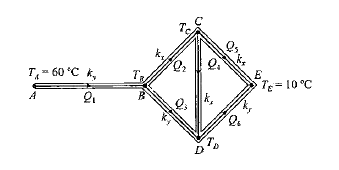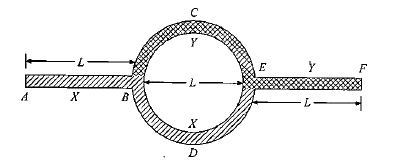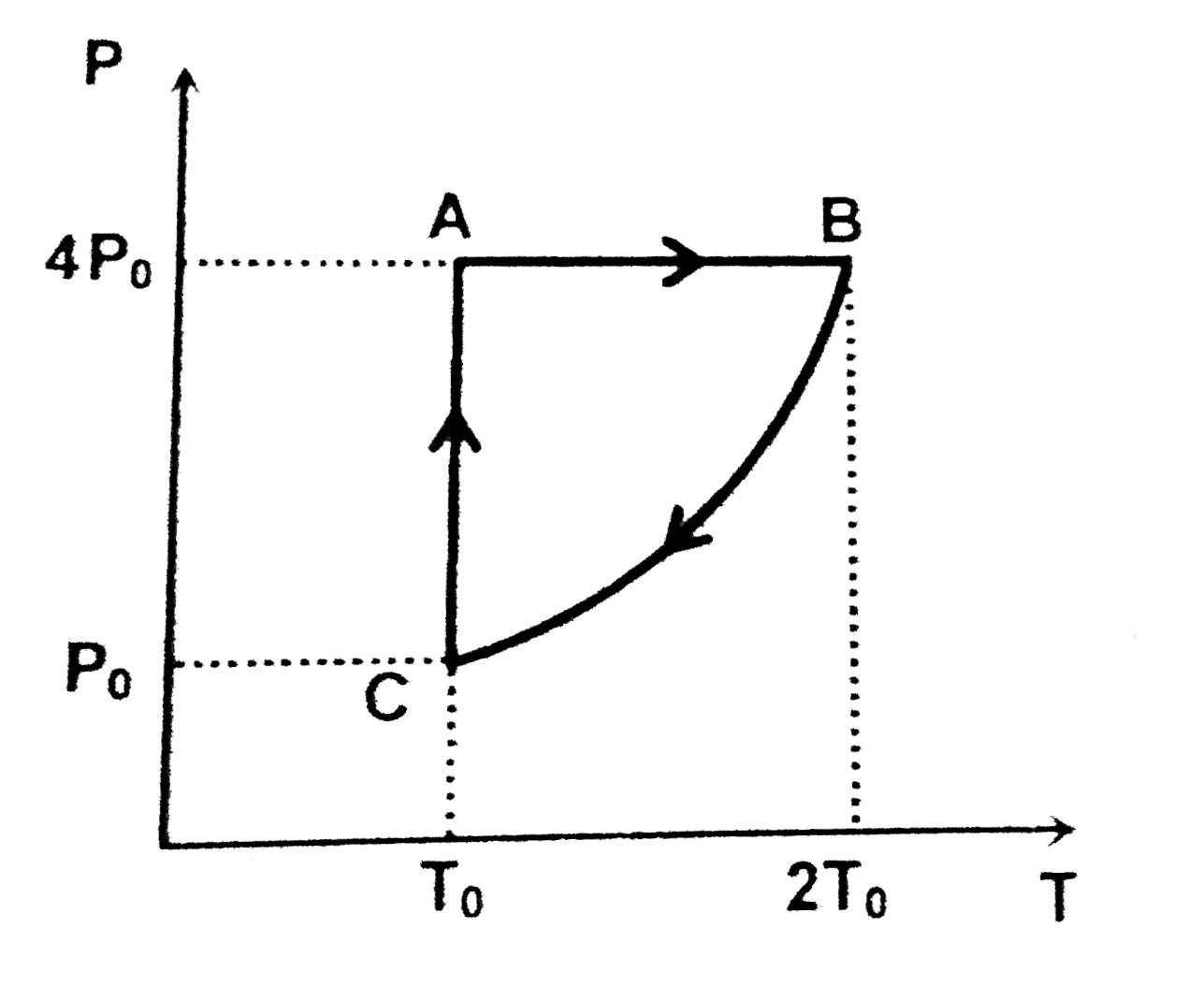A cylindrical rod of 50 cm length and having cross sectional area isused as a conducting material between an ice bath at and a vacuum chamber at as shown in figure. The end of rod which is inside the vacuum chamber behaves like a black body and is at temperature in steady state. Find the thermal conductivity of the material of rod and rate at which ice is melting in the ice bath. Given that latent heat of fusion of ice is ..

It is given that the system is in steady state. This means that any part of rod is not absorbing any heat. So heat absorbed by the end of the rod which is in vacuum chamber by radiation is fully conducted to the ice bath through the rod. Thus we have
Rate of that conduction through the rod =
Rate of heat absorption by radiation for the vacuum chamber
or (kA(T_(B)-T_(A)))/(.L)= sigmaA(T_(vc)^(4)-T_(B)^(4))
or
Using this value of k we can find the rate of heat obtained by the ice bath as
This heat is used to melt the ice in ice bath. If m mass of ice is being melted per second, then we have
or
or .
Topper's Solved these Questions
- HEAT TRANSFER Book:PHYSICS GALAXY - ASHISH ARORAChapter:HEAT TRANSFER Exercise:Illustrative Example 4.18
Explore 1 Video
- HEAT TRANSFER Book:PHYSICS GALAXY - ASHISH ARORAChapter:HEAT TRANSFER Exercise:Illustrative Example 4.19
Explore 1 Video
- HEAT TRANSFER Book:PHYSICS GALAXY - ASHISH ARORAChapter:HEAT TRANSFER Exercise:Illustrative Example 4.16
Explore 1 Video
- HEAT AND THERMAL EXPANSIONBook:PHYSICS GALAXY - ASHISH ARORAChapter:HEAT AND THERMAL EXPANSIONExercise:UNSOLVED NUMRICAL PROBLEMS FOR PREPARATION OF NSEP, INPhO & IPhO
Explore 82 Videos
- Kinetic Theory of Gases and Gas LawsBook:PHYSICS GALAXY - ASHISH ARORAChapter:Kinetic Theory of Gases and Gas LawsExercise:Unsolved Numerical Problems for Preparation of NSEP, INPhO & IPhO
Explore 64 Videos
Similar Questions
Find the rate of heat flow through a cross section of the rod shown in figure (θ2>θ1 . Thermal conductivity of the material of the rod is K.

View SolutionA cylinderical rod of length 50cm and cross sectional area 1cm2 is fitted between a large ice chamber at 0∘C and an evacuated chamber maintained at 27∘C as shown in figure. Only small protions of the rod are insid ethe chamber and the rest is thermally insulated from the surrounding. The cross section going inti the evacuted chamber is blackened so that it completely absorbe any radiation falling on it. The temperatuere of the blackened end is 17∘C when steady state is reachhed. Stefan constant σ=6×10−sWm−2K−4 . Find the thermal conductivity of the material of the rod.

View Solution
Knowledge Check
Steady state temperature are shown in the diagram. Find ratio of thermal conductivity k1k2 if length of all rods are same
 A0.12638888888889B0.12847222222222C0.16805555555556D0.20972222222222
A0.12638888888889B0.12847222222222C0.16805555555556D0.20972222222222A cylindrical rod with one end in a steam chamber and the other end in ice results in melting of 0.1 g of ice per second. If the rod is replaced by another with half the length and double the radius of the first and if the thermal conductivity of material of second rod is 1/4 that of first, the rate at which ice melts in g/s will be
A0.4B0.05C0.2D0.1One end of conducting rod is maintained at temperature 50∘C and at the other end ice is melting at 0∘C. The rate of melting of ice is doubled if:
Athe temperature is made 200∘C and the area of cross-section of the rod is doubledBthe temperature is made 100∘C and the length of the rod is made four timeCarea of cross-section of the rod is halved and length is doubled.Dthe temperature is made 100∘C and area of cross-section of rod and length both are doubled.
The ratio of thermal conductivity of two rods of different materials is "5:4. The two rods of same area and same thermal resistance will have lengths in the ratio :-
View SolutionFew rods of material X and Y are connected as shown in figure - 4.10. The cross sectional area of all the rods are same. If the end A is maintained at 80∘C and the end F is maintained at 10^(@)C~ . Calculate the temperatures of junctions B and E in steady state . Given that thermal conductivty of material X is double that of Y.

View SolutionTemperature of hot end and cold end of a rod, which is in steady state are 100∘C and 40∘C respectively. The area of cross section of rod and its thermal conductivity are uniform. The temperature of rod at its mid point is (Assume no heat loss thorugh lateral surface)
View Solution
Two ends of a rod of uniform cross sectional area are kept at temperature 3T0 and T0 as shown. Thermal conductivity of rod varies as k=αT, (where α is a constant and T is absolute temperature). In steady state, the temperature of the middle section of the rod is
View SolutionTwo rods of copper and brass having the same length and cross - section are joined end to end. The free end of the copper is at 0∘C and of brass is at 80∘C in steady-state. If thermal conductivity of copper is 4 times of that of brass find the temp. at junction of two rods
View Solution